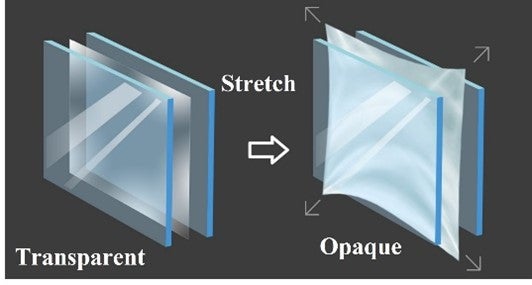Background
Smart windows can switch their transparency and color in response to external stimuli. They are developed to reduce the energy consumption of buildings for cooling, heating, and lighting, which accounts for approximately 40% of total energy demand in developed countries. Current market approaches utilize either electro and thermal actuation to trigger the response via various materials, e.g., polymer dispersed liquid crystals, metal/metal oxide–polymer hybrids and chromogenic materials. Even though electro and thermo-responsive smart windows provide a fast and reversible switch between clear and dark states, their commercial applicability is limited by external power supply constraints, complex fabrication processes and high cost.
Description of the invention
A novel type of latex-polyelectrolyte colloid system has been developed that can be used to make a functional film for sustainable smart windows applications. The optical properties of our smart windows can be tuned by mechanical strain, showing a great potential for emerging applications because of the low cost, energy efficiency, and environmental friendliness. The use of a water based composite material system enables the production of smart windows that have similar or better properties than current applications and with much lower costs and more sustainably by avoiding the use of volatile organic compounds (VOCs) and their associated manufacturing emissions. These smart windows display a high contrast ratio of 7 and stable transparency switching behavior under tensile strain over thousand cycles and have a large breaking elongation of 820%.
Advantages
- Time/Cost Reduction – the raw material for fabricating sustainable materials is much less expensive. All components used in the smart window are already available in the market. No chemical syntheses are involved in the preparation of the smart window, making production safe and cost effective.
- Environmentally friendly - water based without any VOCs such as toluene or formaldehyde in order to ensure health and safety and environmental sustainability.
- Fast switch of transparency – within 1 second.
Potential applications
- Outdoor use for building
- Indoor use for office and bathroom
- Sunroof of vehicles
- Anti-counterfeiting material
- Dynamic light grating
- Strain sensor

Fig. 1. Fabrication of Magic-E material

Fig. 2. Switchable transparency behaviour of Magic-E material under stretching

Fig. 3. Design of smart window
Reference
10197
Patent status
Provisional applicatoin: Magic-E
materials and film for smart window
#63/259,991
Stage of development
Working server prototype and validating application data
Contact
Scott Inwood
Director of Commercialization
Waterloo Commercialization Office
519-888-4567, ext. 43728
sinwood@uwaterloo.ca
uwaterloo.ca/research